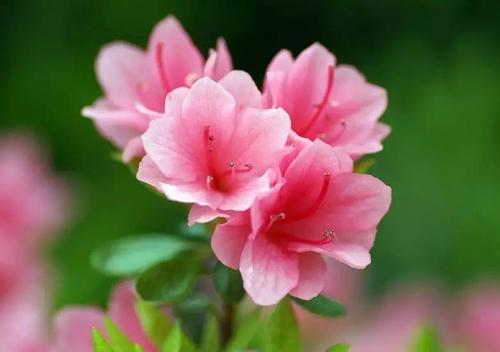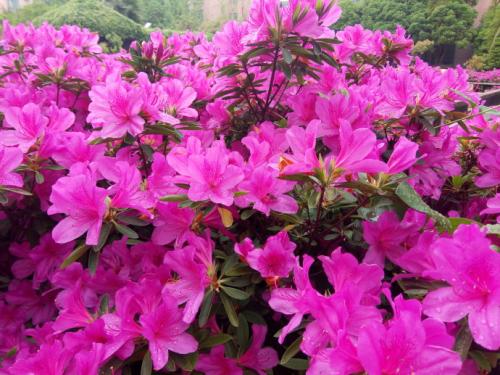Rhododendron mucronulatum (Cornell pink) profile
Written by Maggie
Mar 30 2021

Cornell Pink, scientific name Rhododendron mucronulatum, is a deciduous shrub of the genus Rhododendron Mucronulatum. Cornell Pink is 1 -- 2 m tall and has many branches.
Cornell Pink picture

Morphological characteristics of Cornell pink
Branch
Cornell Pink (Rhododendron mucronulatum) is a deciduous shrub, 12 m tall, with many branches.Young branches are slender, sparsely scaly.
Leaf
Leaf blade of rhododendron cornell pink (Rhododendron mucronulatum) is thin, elliptic or elliptic lanceolate, 3-7 cm long, 1-3.5 cm wide, apex acute, acuminate or obtuse, margin entire or verticulate, base cuneate or obtuse, upper sparsely scaly, subsurface scales vary in size, brown, apart from 2-4 times of its diameter; Petiole of Cornell Pink is 3-5 mm long.
Flowers
Inflorescences of Cornell pink (Rhododendron mucronulatum) axillary branch-terminal or pseudo-terminal, 1-3-flowered, first leaves open, umbellate; Flower bud scales persistent; Pedicels are 5 -- 10 mm long, sparsely scaly; Calyx of Cornell Pink is 0.5-1 mm long, 5-lobed, scaly, glabrous or sparsely setose; Corolla is broadly funnelform, 2.3 -- 2.8 cm long, 3 -- 4 cm in diameter, reddish-purple, outside pubescent, without scales; Cornell Pink has 10 stamens, unequal, slightly shorter than corolla, filaments pubescent below; Ovary of Cornell Pink is 5-loculed, densely scaly, style smooth, longer than corolla.
Fruit
Capsule of rhododendron cornell pink (Rhododendron mucronulatum) is oblong, 1 -- 1.5 cm long, 4 -- 5 mm in diameter, apex 5-petaled.
Cornell pink's ecological habits
Cornell Pink (Rhododendron mucronulatum) likes semi-shade. The soil is loose. The soil moisture is kept around 50-60 and the tap water is watered in the sun for a few days. Adding rice water is even better. Fertilizer around the Spring Festival every year, pay attention to the soil insecticide, such as in the southern soil, no special care, generally can open beautiful flowers.
How to grow and care for Cornell pink
Water care
Rhododendron cornell pink (Rhododendron mucronulatum) requires acidic soils with a pH value of 5.5 to 6.5. Because the northern soil is more alkaline, so the basin soil needs to be mixed with decaying pine coniferous soil and other humus soil. The root system of rhododendron is the fine root with whisker shape, and the requirements of fertilizer concentration and water quality are strict. The principle of timely and proper amount and frequent application of thin fertilizer should be followed when applying fertilizer.I n order to promote the growth of Cornell Pink branches, leaves and buds before spring flowering, phosphate fertilizer can be applied once a month. After anthesis, apply a mixture of nitrogen and phosphorus for 1-2 times. Phosphorus fertilizer was applied 1-2 times during the gestation period. In the growing period, flowering period fertilizer and water requirements are more, winter dormancy, summer growth is slow to control the fertilizer and water, in order to prevent root rot.Azaleas like wet and cool environment, the northern climate is dry, should be timely watering and spray, to maintain high air humidity. Water with alum fertilizer water and rain water as well, such as common water to add a small amount of ferrous sulfate and vinegar. Also can cut watermelon or tomato into small pieces apply, also have a good effect to improve soil quality and flower quality.
The plastic clip
In order to accelerate the rhododendron cornell pink (Rhododendron mucronulatum) blooming, rhododendron often through the heart to promote new branches, for flowers cluster, affect the shape of the flower can be early sparring bud, so not only make the year flowers big color fresh, but also conducive to the plant next year growth and flowering. The germination ability of rhododendron is strong, the branches seriously affect the growth and development of the Cornell Pink, and reduce its ornamental and commercial properties, so it needs to be adjusted by pruning. Pruning is generally carried out in the spring after the flower has faded and autumn. Cut off dead branches, inclined branches, long branches, diseases and insects and some cross branches to avoid nutrient consumption and make the whole plant blossom and plump.
Flowering control
Cornell Pink (Rhododendron mucronulatum) starts flower bud differentiation in the fall, and through refrigeration and heating, the flowering date can be artificially controlled. To make the Cornell Pink blossom in advance, it can be moved to the greenhouse culture, control the temperature at 20-25℃, and often in the branches and leaves of water, maintain more than 80% of the relative humidity, so that after a month and a half can blossom. To make the Cornell Pink delayed flowering, can form the rhododendron bud, let it have been in a low temperature state, maintain the temperature of 2-4℃, pot dry water, summer and autumn moved out of the outdoor, after 2 weeks can be flowering.
How Cornell Pink propagates
Cornell Pink (Rhododendron mucronulatum) can be propagated from seeds, cuttings, and shoots.
Seed propagation
With seed propagation, autumn harvest fruit, put the indoor air is basked in, initiate the fruit dehiscence, collecting tiny seeds, storage in indoor dry place, the following spring sowing, the soil humus soil with high temperature disinfection, spread a thin layer of chopped moss, seeds in the moss, the basin of wet places, 20-30 days or so can sprout, seedling delicate, careful management, can obtain the robust MiaoHe.
Cutting propagation
Cutting propagation is most used in the course of cultivation of rhododendron cornell pink (Rhododendron mucronulatum) propagation methods, generally in 5 - June shearing robust half lignification sections, 5-8 cm long, cut off the lower leaves, keep the parietal lobe 2-3 pieces as cuttings, cuttings base had better use indolebutyric acid or ABT ABT dip dip in processing such as solution, then cutting in osteoporosis breathable, acidic soil rich in humus, keep temperature in 20 to 25 ℃, shade and often spray moisturizing, so as to promote new root germination.
Twig propagation
For rare varieties that are difficult to survive, such as Western Rhododendron, first cut off the tender branches about 3-4 cm as scion, cut the base into wedges with a sharp knife, use rhododendron as rootstock, use the tender branches split, and then put under the shade with plastic film binding, and use plastic bags to cover the scion and rootstock together to protect moisture.

Disease control of cornell pink
Common diseases of rhododendron cornell pink (Rhododendron mucronulatum) include leaf spot, leaf spot, and brown spot, which can be controlled by the following methods:
Swelling of the disease
Before the onset of disease, especially at the time of shoot pumping and leaf spreading, 1:1:200 Bordeaux liquid can be sprayed to remove the diseased leaves in time. Before germination can spray 0.3-0.5 Baumeidu sulphur mixture or 1:1:200 Bordeaux liquid 2-3 times, usually every 7-10 days spray 1 times; After the disease can be sprayed 65-80% mancozeb 500 times liquid or 0.3-0.5 pomei degree sulphur mixture 3-4 times, every 7-10 days spray 1 times.
Leaf spot and brown spot
1000 times 70% methyl torbuzine solution, 4000 times 20% powder ruining solution and 500 times 50% mancozeb solution were sprayed once every 10 days, a total of 7 to 8 times, which could effectively control the development of the disease.In order to prevent leaf yellowing, ferrous sulfate can also be added.
Currency urban disease
Victimized tender branch leaf tip is full of dense white or pink mite quality layers, sometimes the leaf mite gall, caused by aphid stab leaf infection.
Method of prevention and cure
At the same time of removing the diseased leaves, spray the agent containing copper sulfate; Aphids and other stinging pests can be controlled by spraying oxidized dimethyl oil or by placing carbofuran directly in the basin.
Cornell pink's distribution region
Rhododendron cornell pink (Rhododendron mucronulatum) is distributed in Inner Mongolia (up to Manzhouli in the north), Liaoning, Hebei, Shandong and northern Jiangsu.
Cornell Pink is also found in Mongolia, Japan, Korea, Russia (southeast Siberia, Amur).
Cornell Pink ornamental value
Rhododendron cornell pink (Rhododendron mucronulatum) is leafy, germinating, resistant to pruning, and makes an excellent potted plant material.
Cornell Pink is best planted in clusters along forest margins, streams, pools and rocks in gardens. Cornell Pink can also be planted in scattered areas under open forests. Cornell Pink is a good material for hedges.
Cornell Pink (Rhododendron mucronulatum) blooms during the flowering season, giving people a noisy and noisy feeling. The dark green leaves can be planted in the garden as a low wall or screen.

Latest Updated
- Benefits of Bugleweed - 7 Science-backed Health Benefits
- Bugleweed Dangers & Side Effects - Is It Poisonous?
- How to Plant Evergreen Trees - What You Should Know
- When to Plant Evergreens - Grow Guide for Evergreen Trees
- 12 Wonderful Evergreen Shrubs for Your Garden
- 12 Popular Evergreen Plants with Pictures for Beginners
- When And How To Prune A Lilac Bush Like a Pro
- How to Grow & Care for Lilac Vine (Hardenbergia Violacea)
- Japanese Lilac Tree (Syringa Reticulata) Care & Propagation Guide
- Shumard Oak Pros and Cons - What to Know
Popular Articles
- Winter maintenance of Antirrhinum Majus
- How to Grow Terminalia Mantaly Tree
- How to Grow and Care for Crossostephium Chinense
- How to grow Antirrhinum Majus in spring
- Peristeria Elata (Dove Orchid) Profile: Info & Care Guide
- Underwatered Snake Plant (Sansevieria Trifasciata) - Signs And How To Fix
- How to Care for Brazilian Jasmine Plant (Mandevilla Sanderi)
- How to Grow & Care for Graptopetalum Purple Delight in Summer
- Rosa Chinensis (China Rose): Plant Growing & Care Tips
- How to Care for Baby Sun Rose (Aptenia Cordifolia)